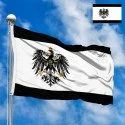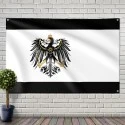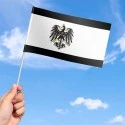The flag of the Kingdom of Prussia, in use from 1892 until the end of the monarchy in 1918, stands as a profound symbol of a state that fundamentally shaped German and European history. It encapsulates the militaristic spirit, monarchical pride, and historical continuity of Prussia, a kingdom renowned for its discipline, administrative efficiency, and pivotal role in the unification of Germany. This particular iteration of the Prussian flag represents the zenith of Prussian power and influence within the German Empire.
Dimensions and Proportions: The primary civil and state flag of the Kingdom of Prussia during this period typically adhered to a proportion of 3:2 (length to height). This ratio ensured a balanced and dignified appearance, suitable for official use on public buildings, at sea for merchant vessels, and by state authorities. While specific dimensions could vary for different applications (e.g., naval ensigns or military standards often had slightly different ratios or additional elements), the 3:2 ratio was the standard for the national flag.
Colors and Arrangement of Elements: The design of the 1892-1918 Prussian flag is a striking horizontal triband of black, white, and black, with the central white stripe being significantly wider than the outer black ones. This pattern is often described as 1:4:1, meaning the black stripes occupied roughly one-sixth of the flag's height each, while the white stripe took up two-thirds.
The central feature of this flag, positioned within the broad white stripe, slightly offset towards the hoist (the side closest to the flagpole), is the iconic Prussian Eagle. This heraldic charge is depicted as a black eagle, facing the hoist, with its wings slightly spread in a dynamic, almost attacking pose.
Key features of the Prussian Eagle on the flag include:
-
Imperial Crown: The eagle is crowned with the majestic Prussian Royal Crown, signifying the kingdom's sovereignty and the Hohenzollern dynasty's authority. This crown is typically gold, adorned with jewels.
-
Regalia: In its right talon, the eagle grasps a golden scepter, symbolizing royal power and justice. In its left talon, it holds a golden orb (Reichsapfel), signifying the monarch's dominion over the realm.
-
Sword: Uniquely, the eagle on this flag is often depicted holding a sword in its right talon, crossed with the scepter. This prominent sword underscores Prussia's strong military tradition and its identity as a martial state.
-
Monogram "FR": On the eagle's breast, prominently displayed, are the intertwined golden initials "FR". These stand for "Fredericus Rex" (Frederick King), a tribute to Frederick I, the first King in Prussia, and more broadly to the enduring legacy of the various Fredericks (most notably Frederick the Great, Frederick II) who shaped Prussian power and identity.
-
Tongue and Claws: The eagle typically has a red tongue, adding a touch of vibrant color, and its claws are golden.
The chosen colors of black and white hold deep symbolic meaning for Prussia:
-
Black: Represents the black eagle, the ancient symbol of the Hohenzollern dynasty, as well as the dark, fertile soil of Brandenburg, the core territory of Prussia. It also symbolizes discipline, seriousness, and military prowess.
-
White: Represents the white field of the ducal banner of Prussia, traditionally associated with purity, justice, and the shining ideals of the monarchy. Together, black and white became the distinctive national colors of Prussia, symbolizing the fusion of order and enlightenment, strength and virtue.
History of the Flag's Creation and Adoption: The flag of the Kingdom of Prussia did not emerge suddenly but evolved over centuries, reflecting the state's growth from a duchy to a powerful kingdom and eventually the leading state in the German Empire. The black and white colors, along with the eagle motif, have been central to Prussian heraldry since the Teutonic Order, from which Prussia largely descended.
-
Early Origins (Teutonic Order): The black eagle on a white field originates from the banner of the Grand Master of the Teutonic Order, a powerful crusading monastic order that established its state in Prussia in the 13th century. The black cross on a white background was also prominent.
-
Ducal Prussia (1525-1701): When Albert of Brandenburg secularized the Teutonic Order's Prussian lands into the Duchy of Prussia in 1525, he retained the black eagle on a white field as his ducal coat of arms. The eagle, now with a ducal crown and the S-shaped monogram of Sigismund I of Poland (whose vassal Albert was), continued this tradition.
-
Kingdom of Prussia (1701-1871): Upon the elevation of Prussia to a kingdom in 1701 under Frederick I, the eagle received a royal crown, and its regalia evolved to include a scepter and orb. The black and white bicolour (horizontal stripes) became the standard national flag, but variations existed for military and state use. The simple black-white-black horizontal flag was adopted as a national and merchant flag in 1818, after the Napoleonic Wars.
-
Evolution to the 1892 Design: The specific design with the eagle offset to the hoist, holding a sword, and bearing the "FR" monogram, was officially adopted on May 28, 1892. This change wasn't a radical departure but a refinement that standardized the flag for the unified German Empire era. It emphasized the kingdom's royal dignity and its central role within the newly formed empire. The earlier flags also featured the eagle, but its exact depiction, placement, and accompanying symbols (like the sword) were standardized in this 1892 decree. This standardization reflected a desire for a consistent national representation in the context of the powerful German Empire.
Country and Regional Context: The Kingdom of Prussia (Königreich Preußen) existed from 1701 to 1918, growing from a relatively small electorate into one of Europe's great powers. Its territory encompassed vast swathes of Central and Eastern Europe, including Brandenburg, Pomerania, Silesia, West Prussia, East Prussia, and later the Rhineland and Westphalia. Berlin, its capital, became the capital of the German Empire in 1871.
Prussia's history is synonymous with military innovation, administrative reform, and the pursuit of national unity. Under leaders like Frederick the Great and Otto von Bismarck, Prussia spearheaded the unification of the German states, culminating in the proclamation of the German Empire in 1871. The Prussian King simultaneously held the title of German Emperor, making Prussia the dominant state within the federal empire. The flag, therefore, symbolized not just a kingdom but the very foundation of the modern German nation-state, representing its core values of order, duty, and military strength.
Significance for Inhabitants: For the people of Prussia, the flag was far more than a mere piece of cloth; it was a potent symbol of their identity, pride, and unwavering loyalty to the Hohenzollern monarchy and the Prussian state.
-
National Pride: It embodied the achievements of Prussia, from its military victories to its administrative excellence and its role as a cultural and intellectual center.
-
Military Tradition: The prominent eagle with the sword reinforced Prussia's image as a disciplined and formidable military power, a source of great pride for a population deeply invested in military service and national defense.
-
Unity and Stability: In a region historically fragmented, the flag represented the stability and unity that Prussia brought, especially after the tumultuous Napoleonic Wars and the successful unification of Germany.
-
Loyalty to the Monarchy: The crown and the "FR" monogram directly linked the flag to the Hohenzollern dynasty, fostering a strong sense of personal loyalty to the King-Emperor.
-
Shared Identity: Whether in East Prussia, Brandenburg, or the newly acquired Rhineland, the black and white flag with its distinctive eagle provided a shared visual identity that transcended regional differences, uniting diverse populations under a common Prussian identity within the larger German Empire.
-
End of an Era: The lowering of this flag in November 1918, following Germany's defeat in World War I and the abdication of Kaiser Wilhelm II, marked the end of the Hohenzollern monarchy and the Kingdom of Prussia itself, ushering in the Weimar Republic. Its legacy, however, remains deeply embedded in German history and vexillology.
Interesting Facts:
-
Iron Cross Connection: While not directly on the civil flag, the Iron Cross, a famous Prussian military decoration, was often depicted on Prussian war flags and royal standards, signifying the intertwining of military and state symbols. The motto "Gott mit uns" (God with us) was also a prominent Prussian and later German imperial motto.
-
Evolution of the Eagle: The Prussian eagle itself underwent several stylistic changes throughout history. The 1892-1918 eagle is a classic rendition, balancing heraldic tradition with a dynamic, powerful appearance, reflecting the assertive stance of the Wilhelminian era.
-
Color Simplicity: The simplicity of the black and white colors, combined with the detailed eagle, created a highly recognizable and impactful flag design. These colors are still associated with Prussia's historical legacy in Germany today.
-
Beyond Prussia: The black and white colors, originating from the Teutonic Order, were later incorporated into the flags of the German Empire (black-white-red) and even influenced some aspects of later German flags, showcasing Prussia's lasting impact on national symbolism.
-
Symbol of German Unification: For many, the Prussian flag of this era became synonymous with German unity and strength, representing the state that forged the modern German nation-state.
In the demonstration images, full-size flags are shown with proportions of 2:3, and hand-held flags with proportions of 1:2.






 Waving flag
Waving flag
 Sizes:
Sizes:
 Round flag
Round flag
 Sizes:
Sizes:
 Rectangular flag 2:3
Rectangular flag 2:3
 Sizes:
Sizes: